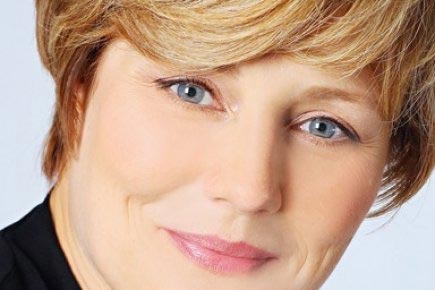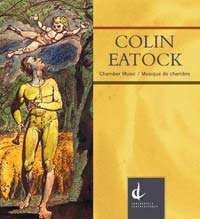 Chamber music is hard. It’s hard to play and even harder to write. Both composer and performer are extremely exposed and it can be at times difficult to communicate between the two. Fortunately, for Dr. Colin Eatock, this process appears to be native and fluent in his recording of Chamber Music. Hailing from Toronto, music writer, critic and composer Eatock, has put forth an exhibition of chamber works that represent a wide range of instrumentation. From voice and harpsichord to brass and piano, he jumps right in and isn’t afraid to show off his compositional chops.
Chamber music is hard. It’s hard to play and even harder to write. Both composer and performer are extremely exposed and it can be at times difficult to communicate between the two. Fortunately, for Dr. Colin Eatock, this process appears to be native and fluent in his recording of Chamber Music. Hailing from Toronto, music writer, critic and composer Eatock, has put forth an exhibition of chamber works that represent a wide range of instrumentation. From voice and harpsichord to brass and piano, he jumps right in and isn’t afraid to show off his compositional chops.
The album begins with the haunting two movement work Ashes of Soldiers (a piece broken into two parts, performed without break). The first part, an instrumental prelude where pianist Peter Longworth and clarinetist Peter Stoll work well to paint Eatock’s conception of a devastatingly fresh battlefield. A minimal (almost ghostly) accompaniment, works delightfully well with the explicit story telling from Walt Whitman’s Leaves of Grass. Eatock does a brilliant job of building long lines and communicating Whitman’s text in the next movement with soprano Melanie Conly, whose crystal-clear diction and distinctive voice seem to be a perfect fit for Mr. Eatock’s vocal writing.

Anita Krause
What is most noticable about Eatock’s songs is his ability to tell a story. The two other cycles that appear on this album also follow a thoughtful text placement. Especially in Tears of Gold, one of two William Blake settings on this album. Cellist Thomas Wiebe makes an excellent duet partner, leading the path for mezzo-soprano Anita Krause to communicate honestly and directly. Occasionally Eatock’s approach comes over as a bit dramatic, yet, fearless. However, he is not afraid to borrow sounds and textures from other periods: it is part of what makes his voice so unique. The harpsichord accompaniment, played by Ian Robertson, speak volumes and fills out a wonderful “old world” texture for these classic American texts.
Likewise, in Three Songs from Blake’s America, Eatock creates a wonderful narrative using William Blake’s chilling “commentary” on the American Revolutionary War. Bass-baritone Andrew Tees and pianist Kate Carver make a bold duo but Tees vocal tone occasionally sounds swallowed and too dark to communicate some of the text which is beautifully crafted. Many of these song settings bring forth a tradition of narrative song writing that has been passed down from Purcell to Vaughan Williams or Schubert to Berg (although mostly English in this case) and this seems very comfortable for Eatock.
His touch with instrumental music, though, is a bit different, a bit more “neo-romantic.” The Suite for Piano, is split in three movements, slow-fast-slow (as music goes). The first movement of the suite begins with a Fantasy that creates a dense and enchanting environment, using extended pedal techniques that “have become a trademark style” of Eatock’s piano writing. He carefully builds these pedal suspensions on top of chordal suspensions, until we’re left with the dust of a chord that lingers from the foot of pianist Timothy Minthorn.
Movement two of the suite, played with extreme precision, features a completely different character. A Toccata (that appears more well suited for a French organ than piano) moves with thorny imitative counterpoint; until the movement ends abruptly, in contrast to the weight of the lingering chords in the previous movement.
The third and final movement brings back the sense of mystery that was left in the first. This time we’re left unguarded with little bass and sparse chords on top that linger in and out of dissonance with the pedal. Interestingly, Eatock classifies this as “signature piece” in that he uses his initials “C” and “E” as arrival and departing points for the work. Therefore we are left with a pedal-supported C that becomes dominant as the work ends.
Other instrumental works include a clever set of Three Canzonas for Brass Quartet performed by the Niagara Brass Ensemble. This is one of the most energetic sets on the entire album. Once again, Eatock isn’t bashful about his period inspiration. He writes in the liner notes, “my inspiration for these three short canzonas was music from the renaissance and Baroque periods, well suited to brass instruments, by such composers as Giovanni Gabrieli and Samuel Scheidt.” Yet Eatock, stunningly, adds his own spice which sounds more Arnold or Holst than Gabrieli or Scheidt.
The final, yet most stunning, work on this album is Trio for Violin, Cello and Piano. Laurel Mascarenhas, violin and Karl Konrad Toews, cello join with Timothy Minthorn, again on the piano, to create a really breathtaking ensemble. With minimal instrumentation Eatock is able to create rich and warm textures that sound more impressionistic in nature, hearkening back from Debussy to Duruflé, and some of the late romantic French chamber music.
 Eatock’s writing is filled with many twists and turns yet he never seems to stray too far from home. His overall sound brings to mind many early to mid 20th century English composers such as Peter Warlock or Herbert Howells, who developed on many of the impressionistic aesthetics of the French composers. The only critique of his instrumental music is that he tends to linger: bathing in one texture for too long before developing and moving on. This seems almost essential for the romantic-like music, but he makes up for all of that by being clear and direct in his motific expression. Colin Eatock’s music is honest, thoughtful and creates a pleasant place for the listener to absorb some of these familiar sounds within new a new context.
Eatock’s writing is filled with many twists and turns yet he never seems to stray too far from home. His overall sound brings to mind many early to mid 20th century English composers such as Peter Warlock or Herbert Howells, who developed on many of the impressionistic aesthetics of the French composers. The only critique of his instrumental music is that he tends to linger: bathing in one texture for too long before developing and moving on. This seems almost essential for the romantic-like music, but he makes up for all of that by being clear and direct in his motific expression. Colin Eatock’s music is honest, thoughtful and creates a pleasant place for the listener to absorb some of these familiar sounds within new a new context.
Colin Eatock, Chamber Music/Musique de Chambre (Centrediscs, 2012) | Buy on Amazon
—
Daniel Garrick is an emerging composer, active performer, writer and creative thinker residing in Jersey City. Follow him on Twitter: @realfaustus.





















